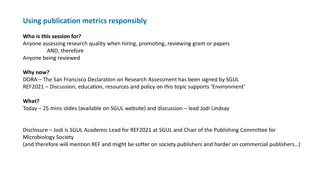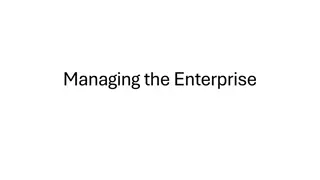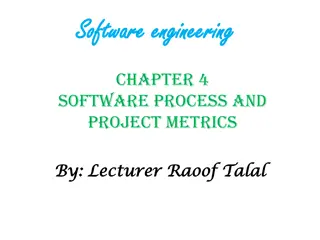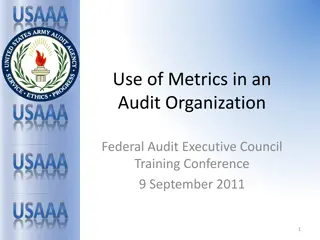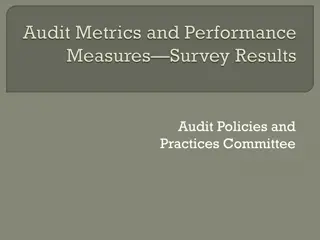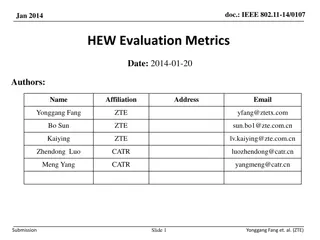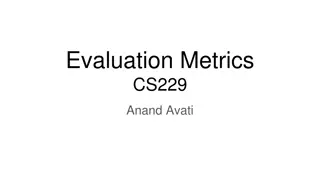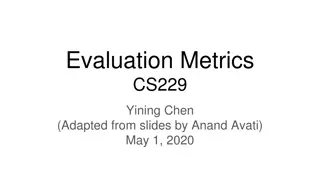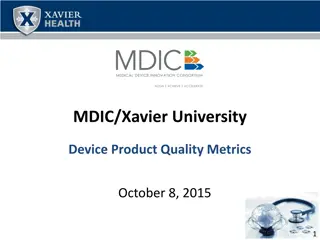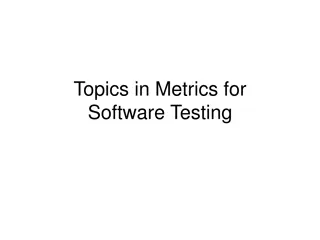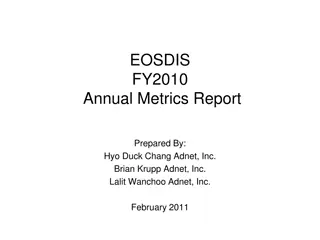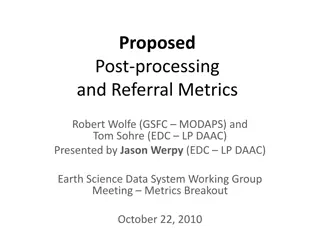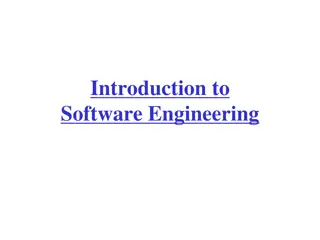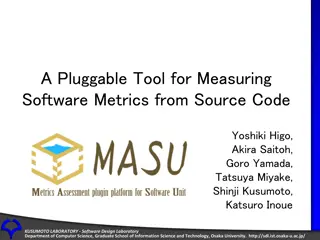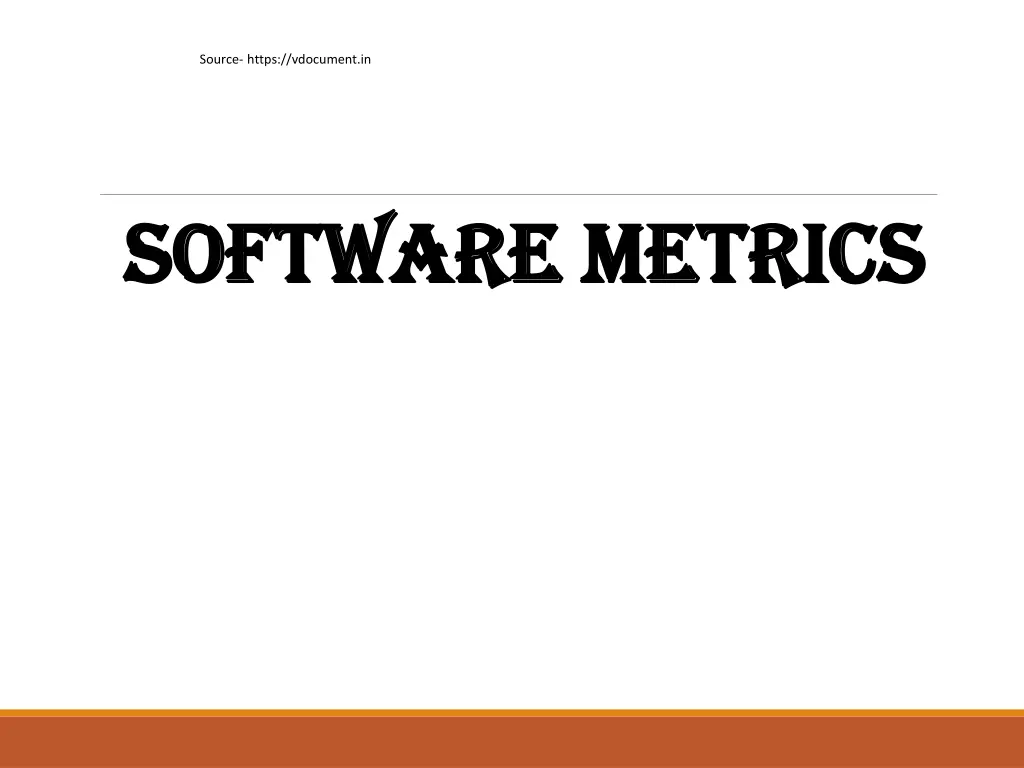
Understanding Software Metrics and Measurement Guidelines
Explore the significance of software metrics, basic terminologies, and measurement guidelines. Learn how metrics can enhance product quality, evaluate performance, and guide process improvement in software development projects.
Download Presentation

Please find below an Image/Link to download the presentation.
The content on the website is provided AS IS for your information and personal use only. It may not be sold, licensed, or shared on other websites without obtaining consent from the author. If you encounter any issues during the download, it is possible that the publisher has removed the file from their server.
You are allowed to download the files provided on this website for personal or commercial use, subject to the condition that they are used lawfully. All files are the property of their respective owners.
The content on the website is provided AS IS for your information and personal use only. It may not be sold, licensed, or shared on other websites without obtaining consent from the author.
E N D
Presentation Transcript
Source-https://vdocument.in Software Metrics Software Metrics
BASIC TERMINOLOGIES BASIC TERMINOLOGIES MEASURE: A quantitative indication of the extent, amount, dimension, or size of some attribute of a product or process (e.g. number of errors) METRICS: The degree to which a system, component, or process possesses a given attribute.It Relates several measures (e.g. average number of errors found per person hour). INDICATORS: An indicator is a metric or combination of metrics that provide insight into the software process, a software project, or the product itself. DIRECT METRICS: Immediately measurable attributes (e.g. line of code, execution speed, defects reported). INDIRECT METRICS: Aspects that are not immediately quantifiable (e.g. functionality, quantity, reliability). MEASUREMENT is the process by which numbers or symbols are assigned to the attributes of the entities in the real world in such a way as to define them accordingly to clearly defined rules. FAULTS: Errors: Faults found by the developers during software development. Defects: Faults found by the customers after release.
WHY MEASURE WHY MEASURE SOFTWARE? SOFTWARE? Establish baselines for comparisons with future assessments. To evaluate the status with respect to plans. Predict qualities of a product or a process by gaining understandings of relationships among process and products. Improve product quality and process performance by identifying roadblocks and inefficiencies.
A Good Manager Measures A Good Manager Measures Process Process metrics Measurement Project metrics Product metrics Product
METRICS GUIDELINES METRICS GUIDELINES Use common sense and organizational sensitivity when interpreting metrics data. Provide regular feedback to the individuals and teams who collect measures and metrics. Don t use metrics to appraise individuals. Work with practitioners and teams to set clear goals and metrics that will be used to achieve them. Never use metrics to threaten individuals or teams. Metrics data that indicate a problem area should not be considered negative. These data are merely an indicator for process improvement. Don t obsess on a single metric to the exclusion of other important metrics.
Product Metrics Product Metrics Product metrics help the software engineers gain insight into the design and construction of the software they build by focussing on specific and measurable attributes of the work products. These metrics examine the requirements model with the intent of predicting the size and complexity of the resulting system.
Function Function- -ORIENTED ORIENTED metrics metrics The Function point (FP) metric can be used effectively as a means for measuring the functionality delivered by a system. The FP metric can be used to - a. Estimate the cost or effort required to design, code and test the software. b. Predict the number of errors that will be encountered during testing c. Forecast the number of components in the system
COMPUTING FUNCTIONAL COMPUTING FUNCTIONAL POINTS POINTS Function points are derived using an empirical relationship based on countable (direct) measures of software's information domain and assessments of software complexity. Information domain values are defined in the following manner: Number of external inputs (EIs) Number of external outputs (EOs) Number of external inquiries (EQs) Number of internal logical files (ILFs) Number of external interface files (EIFs)
Analyzing the Analyzing the Information Domain Information Domain Weighting factor Weighting factor Information Information Domain Value Domain Value Count Count simple average complex simple average complex = = External Inputs ( External Inputs ( EIs) EIs) 3 3 3 3 4 4 6 6 X = = External Outputs ( External Outputs ( EOs) EOs) 3 3 4 4 5 5 7 7 X = = 3 3 External Inquiries ( External Inquiries ( EQs) EQs) 3 3 4 4 6 6 X = = 3 3 Internal Logical Files ( Internal Logical Files ( ILFs) ILFs) 7 7 10 10 15 15 = = 3 3 5 5 7 7 10 10 X External Interface Files ( External Interface Files ( EIFs) EIFs) Count total Count total
Taking Complexity into Account Taking Complexity into Account The Fi( i=1 to 14) are value adjustment factors (VAF) based on responses to the following questions. 1. Does the system require reliable backup and recovery? 2. Are specialized data communications required to transfer information to or from the application? 3. Are there distributed processing functions? 4. Is performance critical? 5. Will the system run in an existing, heavily utilized operational environment? 6. Does the system require online data entry? 7. Does the online data entry require the input transaction to be built over multiple screens or operations? 8. Are the ILFs updated online? 9. Are the inputs, outputs, files, or inquiries complex? 10. Is the internal processing complex? 11. Is the code designed to be reusable? 12. Are conversion and installation included in the design? 13. Is the system designed for multiple installations in different organizations? 14. Is the application designed to facilitate change and ease of use by the user?
Example: Safe Home Example: Safe Home Functionality Functionality
We assume that (Fi) is 38 (a moderately complex product). Therefore, FP = count total X [0.65 +(0.01 X (Fi) )] 50 X [0.65 + (0.01 X 38)] = 51.5
SIZE SIZE- -ORIENTED METRICS ORIENTED METRICS Size oriented metrics are derived by normalizing quality or productivity measures by considering the size of the software that has been produced. A simple set of size-oriented metrics can be developed for each project : Errors per KLOC Defects per KLOC Cost per KLOC Pages of documentation per KLOC
Why Opt for FP? Why Opt for FP? FP is not restricted to code whereas LOC is defined on code. FP is Language independent whereas LOC is not. In FP, the necessary data is available early in a project. We need only a detailed specification whereas in LOC, it is the measure of lines of code which is not available early in the project . FP takes account of functionality or complexity of the product whereas LOC characterize only one specific view of size , namely length .
PROCESS METRICS PROCESS METRICS Process metrics are used for strategic purposes. Process metrics are collected across all projects and over long period of time. Their intent is to provide a set of process indicators that lead to long-term software process improvement. The only way to improve any process is to measure specific attributes of the process, develop a set of meaningful metrics based on the outcomes and then use the metrics to provide indicators that will lead to strategic improvements.
Software Process Software Process Improvement Improvement
PROJECT METRICS PROJECT METRICS Unlike process metrics, software project metrics are used for tactical purposes. Project metrics and the indicators derived from them enables a software project manager to - assess the status of an ongoing project, track potential risks, uncover problem areas before they go critical, adjust work flow or tasks, and evaluate the project team s ability to control quality of software work products. The intent of these metrics is twofold - 1.It is used to minimize the development schedule by making the adjustments necessary to avoid delays and mitigate potential problems and risks 2.It is used to assess product quality on an ongoing basis and, when necessary, modify the technical approach to improve quality. As the quality improves, defects are minimized and the amount of rework required during the project is also reduced , which leads to the reduction in overall project cost.
Measuring Quality Measuring Quality Correctness The degree to which a program operates correctly according to specification. A program must operate correctly or it provides no value to it s users. The most common measure for correctness is the defects per KLOC. Maintainability It is the ease with which a program can be corrected if an error is encountered, adapted if it s environment changes or enhanced if the customer desires a change in the requirements. Integrity This is the measure of the system s ability to withstand attacks to it s security. Usability The degree to which a program is easy to use.
Defect Removal Efficiency Defect Removal Efficiency A quality metric that provides benefit at both the project and the process level is defect removal efficiency. DRE gives a measure of the development team ability to remove defects prior to release. When considered for a project as a whole, DRE is defined as- DRE= E/(E+D) Where E is the number of errors found before delivery of the software to the end-user D is the number of defects found after delivery DRE can also be used within the project to find errors before development team is passed to the next software engineering action. In this context, DRE is defined as- DRE= Ei /(Ei+ E i+1) Where Ei is the no of errors found during engineering action i E i+1 is the no of errors found during engineering action i+1
BIBLIOGRAPHY BIBLIOGRAPHY Software Engineering A Practitioner s Approach, Roger S. Pressman http://www.tutorialspoint.com/index.htm http://www.sqa.net/softwarequalitymetrics.html http://resources.sei.cmu.edu/library/asset-view.cfm?assetid=10537
THANK YOU! THANK YOU!



